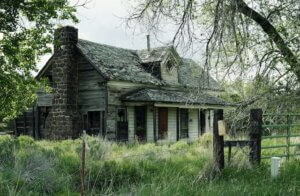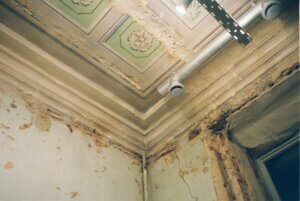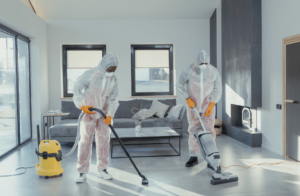The Effects of Mould Growth on Deceased Estate Clean Up
The Effects of Mould Growth on Deceased Estate Clean Up
Summary
Mould growth in deceased estates complicates the already emotional task of property clean-up, presenting health and structural risks. Thriving in damp environments, mould can cause allergic reactions, trigger asthma, and some varieties even produce hazardous toxins. The fungi also damage structural components like walls and flooring. Deceased estate clean up involves assessing the mould extent, safety precautions, thorough cleaning, and professional remediation if needed. Professionals ensure complete removal, preventing future growth while ensuring the property’s safety. It’s crucial to address mould promptly and effectively in such situations.
Mould growth is an unwelcome sight in any property. When dealing with deceased estates, the discovery of mould can add an additional layer of complexity to an already emotional and daunting task. Deceased estate clean up projects require a delicate balance of compassion and thoroughness, and the presence of mould raises health and safety concerns that can’t be overlooked. Let’s delve deeper into the implications of mould in these situations.
Understanding Mould Growth
Moulds are fungi that thrive in moist environments. They spread by releasing spores, which are microscopic and easily carried by air currents. When these spores land on damp surfaces, they begin to grow and multiply. Factors such as poor ventilation, water leaks, or prolonged unattended conditions, which are often present in deceased estates, create the ideal environment for mould growth.
Health Implications
Undertaking a deceased estate clean up, and discovering a mould infestation in the property, can be dangerous for individuals entering the property for extended periods of time. Certain heath implications can arise, including:
Allergens and Irritants: Exposure to mould can cause allergic reactions and irritate the eyes, skin, nose, throat, and lungs. Symptoms include sneezing, runny or stuffy nose, coughing, and skin rashes. For individuals with mould allergies, the reaction can be more severe.
Asthma Triggers: Mould can worsen asthma symptoms. It’s vital to wear protective gear when cleaning mouldy areas, especially for those with respiratory issues.
Toxic Mould: Certain moulds, like the infamous black mould (Stachybotrys Chartarum), produce mycotoxins which can pose severe health risks. Prolonged exposure to these toxins can lead to serious health issues.
Structural Damages
Mould doesn’t just pose health risks; it also undermines the structural integrity of properties. As mould feeds on organic materials like wood, it can weaken structural components and degrade the value of the estate. It can damage walls, ceilings, flooring, and even the foundation, leading to costly repairs and renovations. It is important to have a professional ascertain the structural integrity of a mould-affected property during a deceased estate clean up.
Deceased Estate Clean-Up: Mould Remediation Steps
In more minor cases of mould growth, DIY mould remediation can be undertaken as part of the deceased estate clean up process.
Assessment: The first step is to assess the extent of the mould damage. In some cases, you may need to hire a professional mould inspector.
Safety First: Before initiating the clean-up, equip yourself with protective gear like masks, gloves, and goggles. Ensure the space is well-ventilated.
Isolation: Seal off the mould-affected area to prevent spores from spreading to other parts of the property.
Cleaning and Disinfecting: Non-porous surfaces can often be cleaned with a mixture of water and detergent. However, porous materials like carpets or drywall with extensive mould growth might need to be discarded.
Drying: After cleaning, thoroughly dry the area using fans or dehumidifiers. Mould can resurge if the area remains damp.
Professional Help: If the mould infestation is extensive, or if toxic mould is suspected, it’s wise to seek professional mould remediation services.
The Benefits of Professional Mould Remediation Services
Professional mould remediation offers several significant benefits over DIY methods. First and foremost, experts in the field have specialised equipment and training to handle mould infestations thoroughly and safely, ensuring that all spores are eradicated. This eliminates the risk of recurrence, a common issue in non-professional clean-ups. Secondly, mould specialists are trained to identify the different types of mould, including toxic varieties, and use appropriate techniques for their removal, safeguarding the health of inhabitants. Furthermore, professional remediation also includes steps to prevent future growth, such as identifying and addressing sources of moisture and providing recommendations for property maintenance. Investing in professional services ensures the complete removal of mould and the long-term health and safety of a property’s occupants.
Mould growth in deceased estates can compound the challenges already inherent in handling such properties. It introduces health risks, can damage structural components, and extends the deceased estate clean up process. However, with a thorough understanding of the implications and a systematic approach to mould remediation, it’s possible to restore the property to a safe and habitable state. If you’re ever in doubt, seeking professional help is always the best course of action.
FAQs
What is a deceased estate clean up?
A deceased estate clean up refers to the process of clearing, cleaning, and restoring a property after the death of its owner or inhabitant. This might involve removing personal belongings, addressing maintenance issues, disposing of waste, and sometimes, preparing the property for sale or lease. The process can be both physically and emotionally challenging, given the sentimental value of the items and memories associated with the estate.
How long does a deceased estate clean up typically take?
The duration of a deceased estate clean up varies based on the size of the property, the volume of belongings, and the specific needs of the estate (e.g., repairs, mould remediation, etc.). A small apartment might take a few days to a week, while a larger house filled with years of accumulated items can take several weeks to thoroughly address. Hiring professional services can expedite the process, as they bring expertise and additional resources.
Can I retrieve personal items or mementos during the clean-up?
Absolutely. One of the primary aspects of deceased estate clean up is sorting through personal belongings. Families often wish to keep sentimental items, important documents, or valuables. If you’re hiring professionals, it’s essential to communicate any specific items or categories of possessions you wish to retain, so they can be set aside and handled with care during the clean-up process.
Why Choose AllAces?
When facing the task of a deceased estate clean up, engaging a professional cleaning service is highly recommended. The emotional toll of losing a loved one can be overwhelming and managing the cleaning process on top of everything else can add unnecessary stress. Not to mention, if unexpected services are required including mould, hoarder cleaning and pest control. At AllAces, we offer an extensive range of services to provide our clients with a complete solution.



